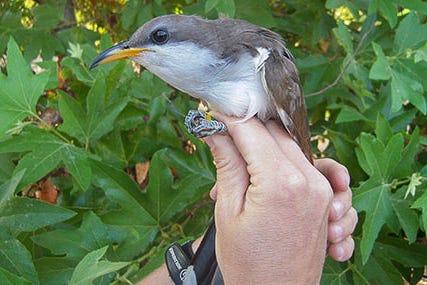Federal government upholds 'threatened' status for yellow-billed cuckoo in New Mexico
 Adrian Hedden
Adrian Hedden
A threatened bird species that dwells along New Mexico rivers could continue to see protection as federal regulators upheld its defense under the Endangered Species Act.
The U.S. Fish and Wildlife Service last week announced it would maintain protections of the yellow-billed cuckoo after years of litigation from environmental groups seeking to encourage the recovery of the bird that suffered population declines and habitat shrinkage in New Mexico, Arizona and California.
The Service proposed 493,655 acres of habitat, including 1,200 linear miles of habitat earlier this year and in a a Sept. 15 decision announced the species would maintain its status as “threatened” under federal law.
The bird was first listed as "threatened" in 2014.
A “threatened” species is one that is considered likely to become endangered and could face extinction.
Support local journalism. Subscribe to the Carlsbad Current-Argus.
The yellow-billed cuckoo is known for a long tail with distinct white markings.
It is also referred to as the “rain crow” for its propensity to sing before storms.
The bird traditionally breeds in streams alongside cottonwood and willow forests and small stream banks during monsoon rains when plants receive increased water and turn green.
MORE:Lesser prairie chicken population growing in southeast New Mexico despite no listing
Michael Robinson of the Center for Biological diversity said the Service’s decision was a win for the species, but that it must next see its habitat designated as “critical” to protect the animal when it migrates to the U.S. from South America in the summer.
“We’re grateful that this wondrous bird will continue to receive the life-saving protections of the Endangered Species Act,” Robinson said. “Now it’s time to designate critical habitat to ensure that when the cuckoos migrate here each summer from South America, they’ll still have places to nest and fledge their chicks.”
The Service initially proposed that acreage the bird nests in and multiply in February.
MORE:New Mexico attorney general joins effort against proposed changes to Endangered Species Act
In 2014, 546,335 acres were proposed as the species’ population had dwindles 680 to 1,025 nesting pairs, including 350 to 495 pairs in the U.S. and Mexico.

Robinson blamed development along the rivers, including dams, mining and ranching for the bird’s struggles.
He said restoring the cuckoo’s population would also benefit the health of the rivers which people also rely on.
“We’re delighted to see cuckoos and the rivers these songbirds need to survive on the path to getting long-overdue protection,” Robinson said. “Dams, mining, development and cows have all harmed the West’s once-verdant rivers, and this proposal should help heal some of those injuries. That’ll help people, too, since we also depend on these rivers.”
MORE:Oil and gas impacts cited in possible listing of dunes sagebrush lizard as endangered
The updated proposal earlier this year eliminated areas in California, Nevada and Wyoming but added proposed critical habitat areas in New Mexico and Arizona.
The areas now include the Gila, San Francisco and Mimbres rivers in New Mexico, along with the Sacramento, South Fork Kern and Colorado rivers in California.
The Gila, San Pedro and Santa Cruz rivers in Arizona were also proposed for protection, along with the Colorado and Gunnison rivers in Colorado and the Snake and Henry’s Fork rivers in Idaho.
MORE:Protected osprey roosting on TDS billboard shot and killed in Carlsbad
The Green River in Utah and Terlingua Creek in Texas were also listed as possible areas to be protected.
“The cuckoo’s decline brings us a message about the desperate situation of western rivers,” Robinson said. “Protecting this bird’s habitat has only upsides. No downsides. We’ll continue to push for protecting more rivers for this fascinating bird.”
In its proposal the Fish and Wildlife Service sought to not only protect areas occupied by the cuckoo, but also non-occupied areas the bird could used based on changing conditions from year to year.
“For example, some breeding habitat that is not suitable one year may become suitable the next due to increased rainfall or flooding events. Other areas currently suitable and occupied may become degraded due to age or other environmental condition,” read the proposal.
“Therefore, in our proposed determination of the extent of critical habitat, we took into account this need to accommodate the dynamic nature of existing habitat.”
MORE:Endangered Mexican gray wolf's regrowth worries southern New Mexico ranchers
The Service also cited in its proposal that all of the areas supporting the yellow-billed cuckoo were under threat from development and climate change, but that installing the proposed protections could lead to species’ resurgence in its primary breeding grounds in Arizona and New Mexico.
“Providing for a variety of habitat (i.e. representation) primarily where the U.S. core breeding population occurs in Arizona and New Mexico (redundancy) may provide for amelioration against these threats and provide for the conservation of the species,” read the proposal.
Adrian Hedden can be reached at 575-628-5516, achedden@currentargus.com or @AdrianHedden on Twitter.